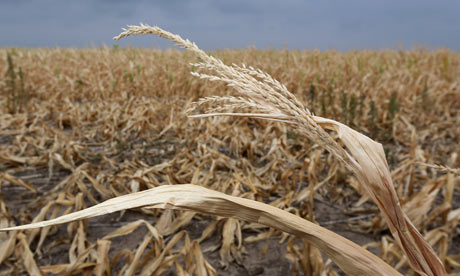The most Severe and Extensive Drought in at least 25 years is seriously affecting U.S. agriculture, with impacts on the crop and livestock sectors and with the potential to affect food prices at the retail level. Crop conditions for Winter Wheat in the U.S. declined for the fourth straight week and were the worst since 1985, the government said, as dry, cold weather slowed seed germination and early plant growth. An estimated 33 percent of the crop was rated good or excellent as of yesterday, down from 34 percent last week and 52 percent a year earlier, the U.S. Department of Agriculture said today in a report. About 26 percent was in poor or very poor condition, compared with 13 percent a year earlier.The worst U.S. drought since 1956 helped send wheat futures up 32 percent this year.
Dry, warm weather is expected over the next 10 days, which will slow root development before plants go dormant for the winter, according to T-Storm Weather LLC in Chicago. About 46 percent of the wheat crop from Texas to Montana received less than half the average rain during the last 90 days, the forecaster said. Winter wheat is the most-common variety in the U.S., accounting for about 72 percent of all wheat harvested. The plants go dormant during the coldest months of the year and resume growing in March. The drought conditions already cut output of the nation’s two biggest crops, corn and soybeans, sending prices to record highs earlier this year. On Jan. 11, the USDA is scheduled to release its first estimate of the 2012-2013 acreage seeded with winter wheat.
Related articles
- U.S. Winter Wheat Withers to 1985 Lows as Drought Persists (bloomberg.com)
- Winter wheat prices rise as conditions deteriorate (miamiherald.com)


 (Oct 5, 2012) World food prices rose in September and are moving nearer to levels reached during the 2008 food crisis.The
(Oct 5, 2012) World food prices rose in September and are moving nearer to levels reached during the 2008 food crisis.The  Sept 18, 2012) The first eight months of 2012 were the hottest ever recorded in the
Sept 18, 2012) The first eight months of 2012 were the hottest ever recorded in the